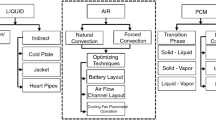Abstract
A good thermal management system can effectively improve the performance of the lithium-ion battery and ensure the thermal safety of the lithium-ion battery. Therefore, based on the heat-generating characteristics of lithium-ion batteries obtained above, this paper established a composite thermal management system including heat pipes, thermally conductive silica gel, phase change materials, and microchannel liquid cooling plates. The velocity uniformity coefficient, friction resistance coefficient, and thermal characteristic parameters are used as evaluation indicators, and the thermal management system inlet flow is optimized to obtain the optimal inlet flow of the thermal management system. Based on this, the thermal management capability of the established thermal management system under different operating conditions of the lithium-ion battery is analyzed. It is advisable to select 0.67L/min as the inlet flow rate of the microchannel liquid-cooled plate of the composite thermal management system.











Similar content being viewed by others
References
Kwon H, Park H (2019) Numerical simulation of prismatic lithium-ion battery life cycles under a wide range of temperature[J]. Int J Precis Eng Manuf Green Technol 6(1):63–73
Prasad A, Parhizi M, Jain A (2019) Experimental and numerical investigation of heat transfer in Li-ion battery pack of a hoverboard[J]. Int J Energy Res
Donal P, Finegan Bernhard T (2017) Tracking internal temperature and structural dynamics during nail penetration of lithium-ion cells[J]. J Electrochem Soc 164(13):3285–3291
Tang Z, Min X, Song A et al (2019) Thermal management of a cylindrical lithium-ion battery module using a multichannel wavy tube[J]. J Energy Eng 145(1):04018072.1–04018072.9
Xu X, Tong G, Li R (2020) Numerical study and optimizing on cold plate splitter for lithium battery thermal management system[J]. Appl Therm Eng 167(11):114787
Zhou H, Zhou F, Wang Q, et al (2019) Thermal management of cylindrical lithium-ion battery based on a liquid cooling method with half-helical duct[J]. Appl Therm Eng 114257
Jiang Z, Qu Z (2019) Lithium-ion battery thermal management using heat pipe and phase change material during the discharge-charge cycle: a comprehensive numerical study[J]. Appl Energy 242(PT.1-1284):378–392
Chang C, Huang S, Chen W (2019) Thermal and solid electrolyte interphase characterization of lithium-ion battery[J]. Energy 174(May 1):999–1011
Cao W, Zhao C, Wang Y et al (2019) Thermal modeling of full-size-scale cylindrical battery pack cooled by channeled liquid flow[J]. Int J Heat Mass Transf 138(AUG):1178–1187
Martín M, Leire, Gastelurrutia J, et al (2019) Optimization of thermal management systems for vertical elevation applications powered by lithium-ion batteries[J]. Appl Therm Eng 147:155–166
Huo Y, Rao Z, Liu X et al (2015) Investigation of power battery thermal management by using mini-channel cold plate[J]. Energy Convers Manag 89(jan):387–395
Jarrett A, Kim I (2014) Influence of operating conditions on the optimum design of electric vehicle battery cooling plates[J]. J Power Sources 245(jan.1):644–655
Ye X, Zhao Y, Quan Z (2018) Experimental study on heat dissipation for lithium-ion battery based on micro heat pipe array (MHPA). Appl Therm Eng 130:74–82
Tran T, Harmand S, Sahut B (2014) Experimental investigation on heat pipe cooling for hybrid electric vehicle and electric vehicle lithium-ion battery. J Power Sources 265:262–272
Javani N, Dincer I, Naterer G et al (2014) Modeling of passive thermal management for electrical vehicle battery packs with PCM between cells[J]. Appl Therm Eng 73(1):307–316
Wilke S, Schweitzer B, Khateeb S et al (2017) Preventing thermal runaway propagation in lithium ion battery packs using a phase change composite material: an experimental study[J]. J Power Sources 340:51–59
Chengning Z, Xin J, Junqiu L (2017) PTC Self-heating experiments and thermal modeling of lithium-ion battery pack in electric vehicles[J]. Energies 10(4):572
Lei Z, Zhang Y, Lei X (2018) Improving temperature uniformity of a lithium-ion battery by intermittent heating method in cold climate[J]. Int J Heat Mass Transf 121:275–281
Wang Y, Wang H, Zhang Y et al (2021) Thermal oxidation characteristics for smoke particles 1 from an abused prismatic Li(Ni0.6Co0.2Mn0.2)O2 Battery 2[J]. The Journal of Energy Storage 39(1)
Wang Y, Gao Q, Wang H (2020) Structural design and its thermal management performance for battery modules based on refrigerant cooling method[J]. Int J Energy Res 45(9)
Zhang Y, Wang H , Wang Y et al (2020) Thermal abusive experimental research on the large-format lithium-ion battery using a buried dual-sensor[J]. Journal of Energy Storage 33
Zhang T, Gao Q, Wang G et al (2017) Investigation on the promotion of temperature uniformity for the designed battery pack with liquid flow in cooling process[J]. Appl Therm Eng 116(Complete):655–662
Zhu J, Sun Z, Wei X et al (2016) An alternating current heating method for lithium-ion batteries from subzero temperatures[J]. Int J Energy Res 40(13):1869–1883
Qu Z, Jiang Z, Wang Q (2019) Experimental study on pulse self-heating of lithium-ion battery at low temperature[J]. Int J Heat Mass Transf 135(JUN):696–705
Panchal S, Dincer I, Agelin M, Fowler M et al (2016) Experimental and theoretical investigation of temperature distributions in a prismatic lithium-ion battery[J]. Int J Therm Sci 99:204-212
Melcher A, Ziebert C, Rohde M et al (2016) Modeling and simulation the thermal runaway behavior of cylindrical Li-ion cells—computing of critical parameter [J]. Energies 9(4):292
Fu J, Xu X, Li R (2019) Battery module thermal management based on liquid cold plate with heat transfer enhanced fin[J]. Int J Energy Res 43(8):4312–4321
Babapoor A, Azizi M, Karimi G (2015) Thermal management of a Li-ion battery using carbon fiber-PCM composites[J]. Appl Therm Eng 82:281–290
Bernardi D, Pawlikowski E, Newman J (1985) A general energy balance for battery systems[J]. J Electrochem Soc 132(1):5–12
Funding
The project is supported partly by the National Natural Science Foundation of China (51875259) and Foundation of State Key Laboratory of Automotive Simulation and Control (20180103).
Author information
Authors and Affiliations
Corresponding authors
Additional information
Publisher's note
Springer Nature remains neutral with regard to jurisdictional claims in published maps and institutional affiliations.
Rights and permissions
About this article
Cite this article
Zhang, L., Yuan, Q., Hu, S. et al. Research on performance of thermal management system integrated with multiple heat exchange methods. Ionics 28, 789–799 (2022). https://doi.org/10.1007/s11581-021-04334-0
Received:
Revised:
Accepted:
Published:
Issue Date:
DOI: https://doi.org/10.1007/s11581-021-04334-0




